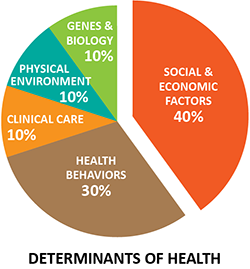 Creating
Creating
Health Equity
in Minnesota
Minnesota, on average, ranks among the healthiest states in the nation. But those averages do not tell the whole story. Minnesota has some of the greatest health disparities in the country between whites and people of color and American Indians. Why is this? and What can Minnesota do to advance health equity?
What makes us healthy?
What creates health? The common belief is that good health is due to personal choices and great medical care. These do influence health and are important. But the reality is that clinical care is a relatively small contributor to overall health - around 10 percent. Some models suggest that the biggest contributors to health are socio-economic factors like education, income, individual and community-level wealth, mobility and housing.
It is not surprising that Minnesota has some of the worst health disparities in the country, because it has significant inequalities in areas such as income, education and home ownership.

Finding a solution
To be healthy, people need peace, shelter, education, food, income, and social justice. In short, health is created where people live, work, and play. Minnesota's significant and long-lasting health inequities cannot be explained by bio-genetic factors and personal choice. These health differences have in part resulted from structural racism, which refers to racism that is built into systems and policies, rather than individual prejudice. Creating health equity requires a comprehensive solution that includes but goes beyond targeted grants and access to health care. Minnesota needs to address health disparities as part of a broad spectrum of public investments in housing, transportation, education, economic opportunity and criminal justice. Learn more about Minnesota's approach in the Advancing Health Equity Report.